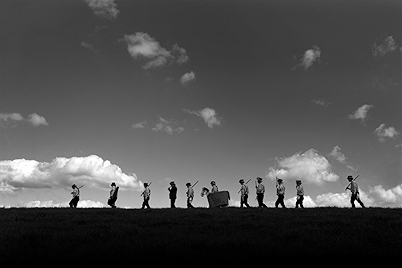A movie for every day of the year – a good one
8 May
First commemorative period of silence proposed, 1919
On this day in 1919, Edward George Honey, an Australian former soldier and journalist, first proposed the idea of a silence to honour the dead of the Great War. He was living in London at the time, and suggested it in a letter written to the London Evening News. Honey mooted a five minute silence, to commune with “the Glorious Dead who won us peace”, having been upset by the sight of people dancing in the streets on Armistice Day in 1918. Honey’s idea was either taken up by Sir Percy Fitzpatrick, or Fitzpatrick came up with it entirely coincidentally, no one is sure. Either way it was Fitzpatrick who suggested the idea to King George V. The two minute silence, as it had become on its journey, was first observed on the first anniversary of the signing of the armistice, at 11 o’clock on the 11th day of the 11th month, in 1919.
Way of the Morris (2011, dir: Rob Curry, Tim Plester)
Here’s a really gentle documentary about Morris dancing, a tradition that goes back into the mists of antiquity in England, which sees stout yeomen of the parish dancing through the streets, adorned with handkerchiefs and bells, striking sticks together as they leap into the air. It might be a fertility dance reaching back to pagan times, it might have been a Moorish (ie North African) import, which would explain why some Morris dancers black up, no one is particularly sure.
What we do know about Morris dancing is that it makes people slightly nervous, tittersome. It’s uncool. And in a country that is generally proud of its multiculturalism, occasionally even slightly suspect. Co-director Tim Plester is our guide, a man whose family have connections to the Adderbury Morris in Oxfordshire, though Tim himself has never danced it, and the documentary is to an extent a personal journey – How I Got My Morris Back. We learn that there is a distinct class element to Morris dancing. That it is danced by skilled working men, and that the reason why it died out in Adderbury was that only one man from the team came back alive after the First World War. That it came back to life at all was as a result of the 1960s folk renaissance which saw the likes of Fairport Convention gain a toehold on the zeitgeist, and we learn from the man who revived it in Adderbury that he gained the seal of approval for what he was doing from the spirit of that returnee from the Great War by dancing outside his old house.
That bit of dopy spirituality is entirely what this film is about, what Morris dancing is about – men who can’t dance, don’t really do God, who work with their hands, aren’t particularly handsome, young or hip, doing something out of a sense of fondness rather than passion. Passion would be too… unEnglish. As I say, it’s a really gentle documentary that somehow gets closer to the soul of what might be called ethnic Englishness – the stuff that survives out in the villages far away from the dominant culture of the city.
Everyone interviewed by the engaging and diffident Plester is aware that there is a potential for this all to be misappropriated – Morris dancing as some sort of rallying point for neo-Nazis. Which, presumably, is why you see the odd Darth Vader helmet bobbing up and down along with the traditional horse’s head or fool’s hat. The silliness makes Morris dancing strangely invulnerable to misappropriation.
Why Watch?
- What do you know about Morris dancing?
- Well researched
- A poignant reminder of the cost of the First World War
- The folk revival continues
Way of the Morris – at Amazon
I am an Amazon affiliate
© Steve Morrissey 2014

